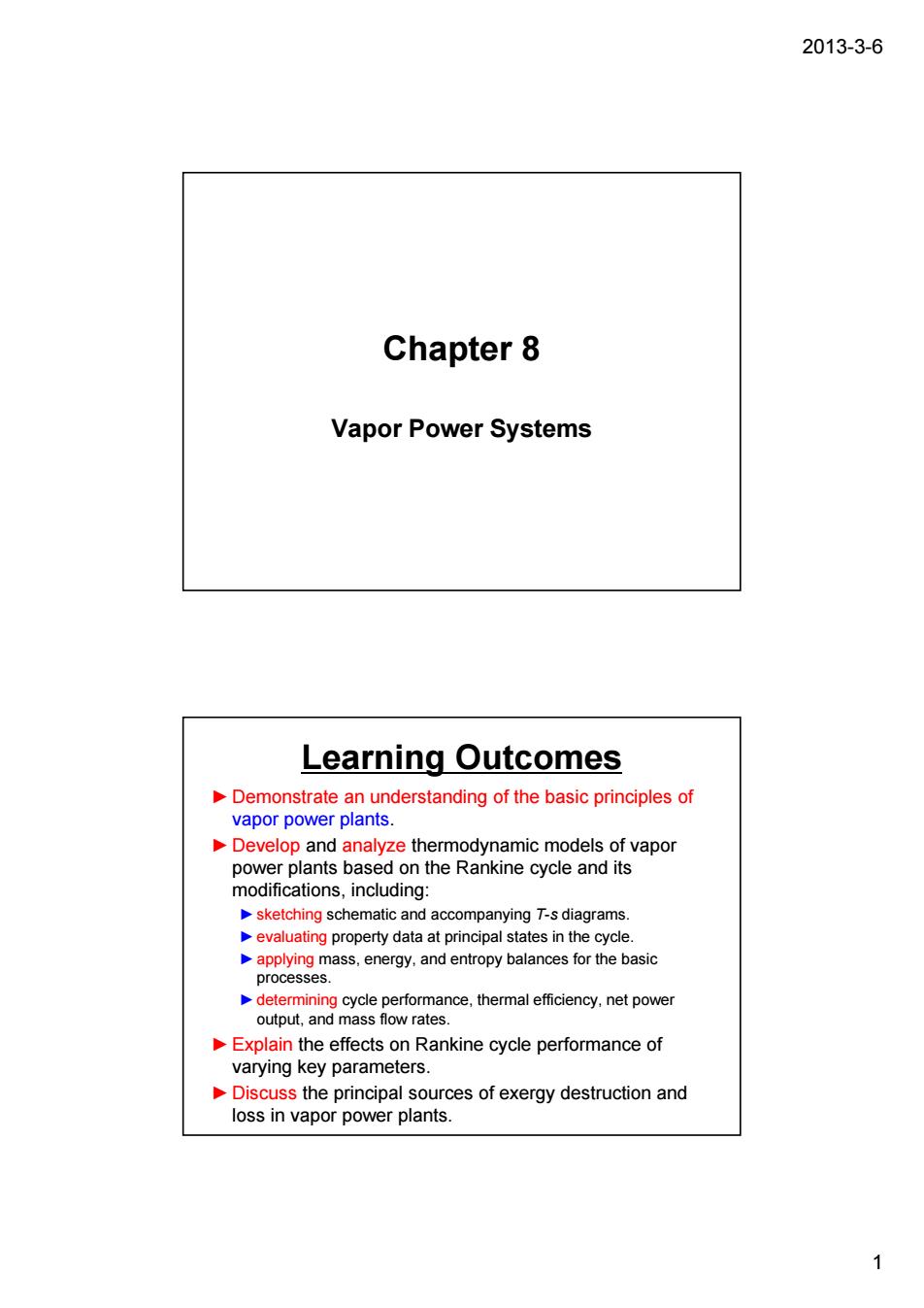
2013-3-6 Chapter 8 Vapor Power Systems Learning Outcomes Demonstrate an understanding of the basic principles of vapor power plants. Develop and analyze thermodynamic models of vapor power plants based on the Rankine cycle and its modifications,including: npropery data at prinpain thye. y determining cycle performance,thermal efficiency.net power output,and mass flow rates. Explain the effects on Rankine cycle performance of varying key parameters. s the principal sources of exergy destruction and
2013-3-6 1 Chapter 8 Vapor Power Systems Learning Outcomes ►Demonstrate an understanding of the basic principles of vapor power plants. ►Develop and analyze thermodynamic models of vapor power plants based on the Rankine cycle and its modifications, including: ►sketching schematic and accompanying T-s diagrams. ►evaluating property data at principal states in the cycle. ►applying mass, energy, and entropy balances for the basic processes. ►determining cycle performance, thermal efficiency, net power output, and mass flow rates. ►Explain the effects on Rankine cycle performance of varying key parameters. ►Discuss the principal sources of exergy destruction and loss in vapor power plants
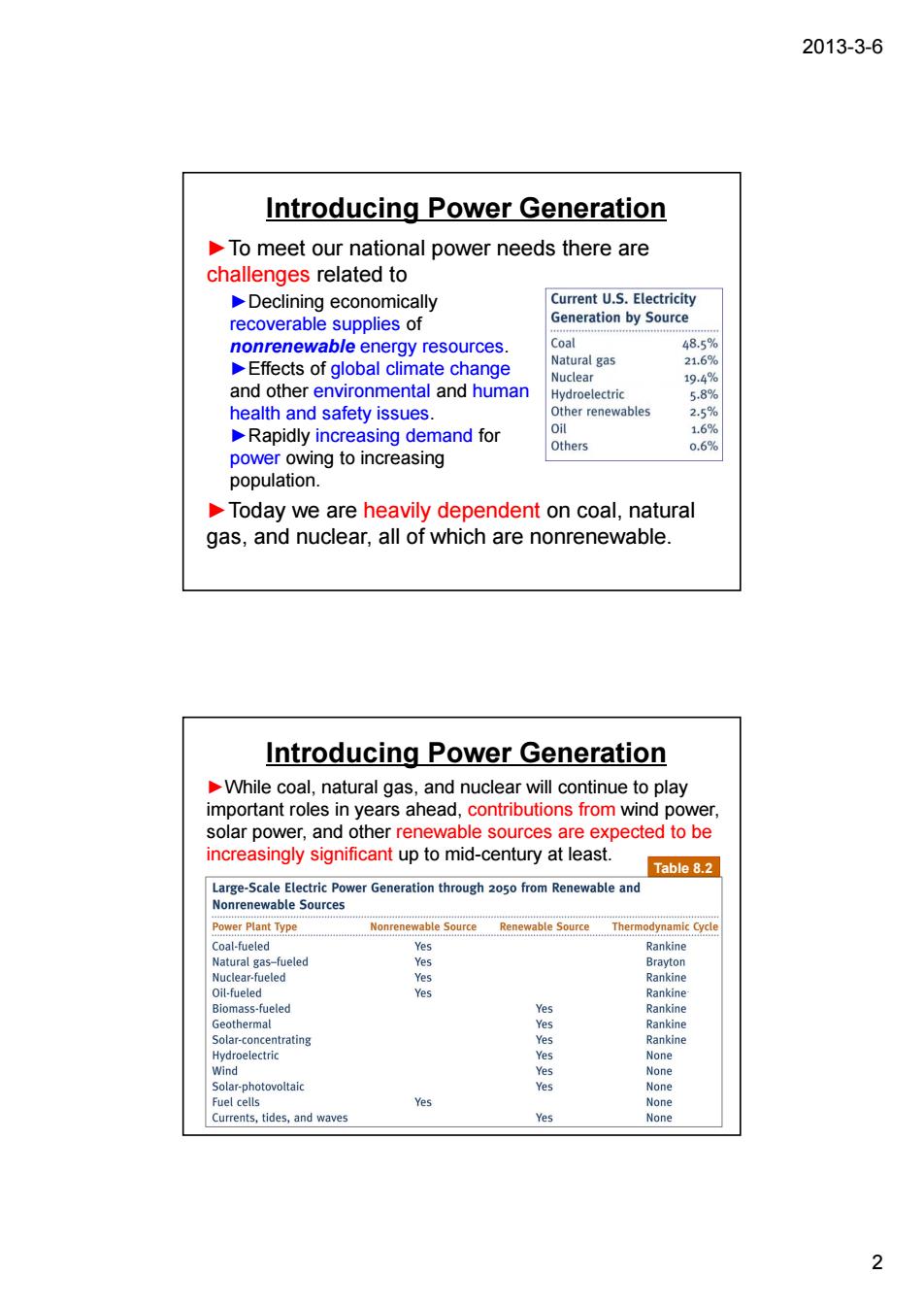
2013-3-6 Introducing Power Generation To meet our national power needs there are challenges related to Declining economically Current U.S.Electricity recoverable supplies of eration by Sour nonrenewable energy resources. Coal al gas 48.5 Effects of global climate change and other environmental and human ectric health and safety issues. Other renewables Rapidly increasing demand for power owing to increasing Others population. Today we are heavily dependent on coal,natural gas,and nuclear,all of which are nonrenewable. Introducing Power Generation While coal,natural gas,and nuclear will continue to play important roles in years ahead,contributions from wind power solar power,and other renewable sources are expected to be increasingly significant up to mid-century at least. Table 8.2 LacaleEectric Powerrioufrom Renewable and wable Source Renewable Source oal-fueled electric Yes 2
2013-3-6 2 Introducing Power Generation ►To meet our national power needs there are challenges related to ►Today we are heavily dependent on coal, natural gas, and nuclear, all of which are nonrenewable. ►Declining economically recoverable supplies of nonrenewable energy resources. ►Effects of global climate change and other environmental and human health and safety issues. ►Rapidly increasing demand for power owing to increasing population. Table 8.2 Introducing Power Generation ►While coal, natural gas, and nuclear will continue to play important roles in years ahead, contributions from wind power, solar power, and other renewable sources are expected to be increasingly significant up to mid-century at least

2013-3-6 Introducing Power Generation Table 8.2 also shows that thermodynamic cycles are a fundamental aspect of several power plant types that employ renewable or nonrenewable sources. In Chapters 8 and 9.vapor power systems,gas turbine power systems,and internal combustion engines are studied as thermodynamic cycles. Vapor power systems in which a working fluid is alternately vaporized and condensed is the focus of Chapter 8.The basic building block of vapor power systems is the Rankine cycle. Introducing Vapor Power Plants The components of four alternative vapor power plant configurations are shown schematically in Fig 8.1.They are Fossil-fueled vapor power plants. Pressurized-water reactor nuclear vapor power plants. Concentrating solar thermal vapor power plants Geothermal vapor power plants. In each of the four types of vapor power plant,a working fluid is alternately vaporized and condensed A key difference among the plants is the origin of the energy required to vaporize the working fluid. 3
2013-3-6 3 Introducing Power Generation ►Table 8.2 also shows that thermodynamic cycles are a fundamental aspect of several power plant types that employ renewable or nonrenewable sources. ►In Chapters 8 and 9, vapor power systems, gas turbine power systems, and internal combustion engines are studied as thermodynamic cycles. Vapor power systems in which a working fluid is alternately vaporized and condensed is the focus of Chapter 8. The basic building block of vapor power systems is the Rankine cycle. Introducing Vapor Power Plants ►The components of four alternative vapor power plant configurations are shown schematically in Fig. 8.1. They are ►Fossil-fueled vapor power plants. ►Pressurized-water reactor nuclear vapor power plants. ►Concentrating solar thermal vapor power plants. ►Geothermal vapor power plants. ►In each of the four types of vapor power plant, a working fluid is alternately vaporized and condensed. A key difference among the plants is the origin of the energy required to vaporize the working fluid
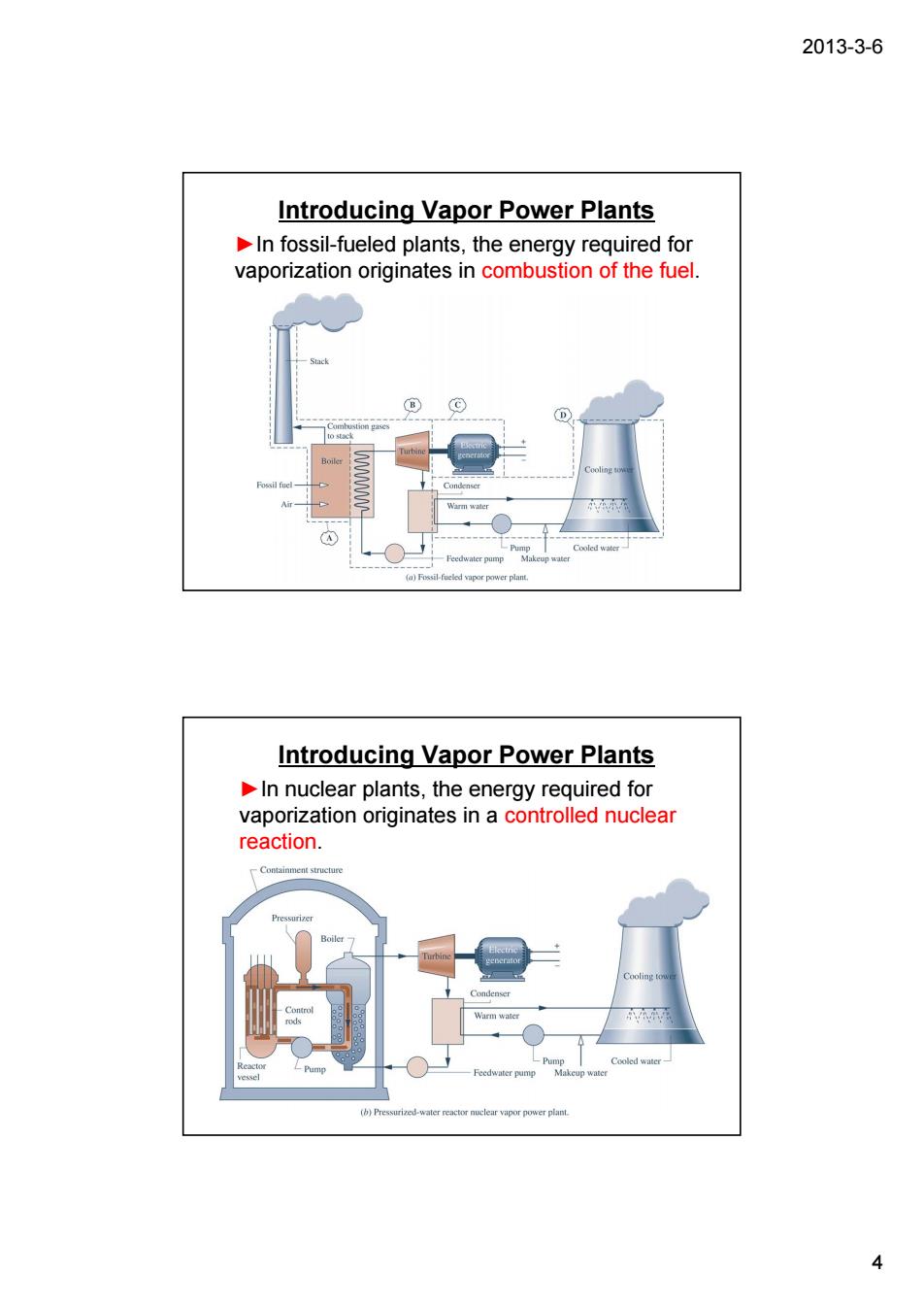
2013-3-6 Introducing Vapor Power Plants In fossil-fueled plants,the energy required for vaporization originates in combustion of the fuel. Fail-fuled vapor pover pr Introducing Vapor Power Plants In nuclear plants,the energy required for vaporization originates in a controlled nuclear reaction. 4
2013-3-6 4 Introducing Vapor Power Plants ►In fossil-fueled plants, the energy required for vaporization originates in combustion of the fuel. Introducing Vapor Power Plants ►In nuclear plants, the energy required for vaporization originates in a controlled nuclear reaction
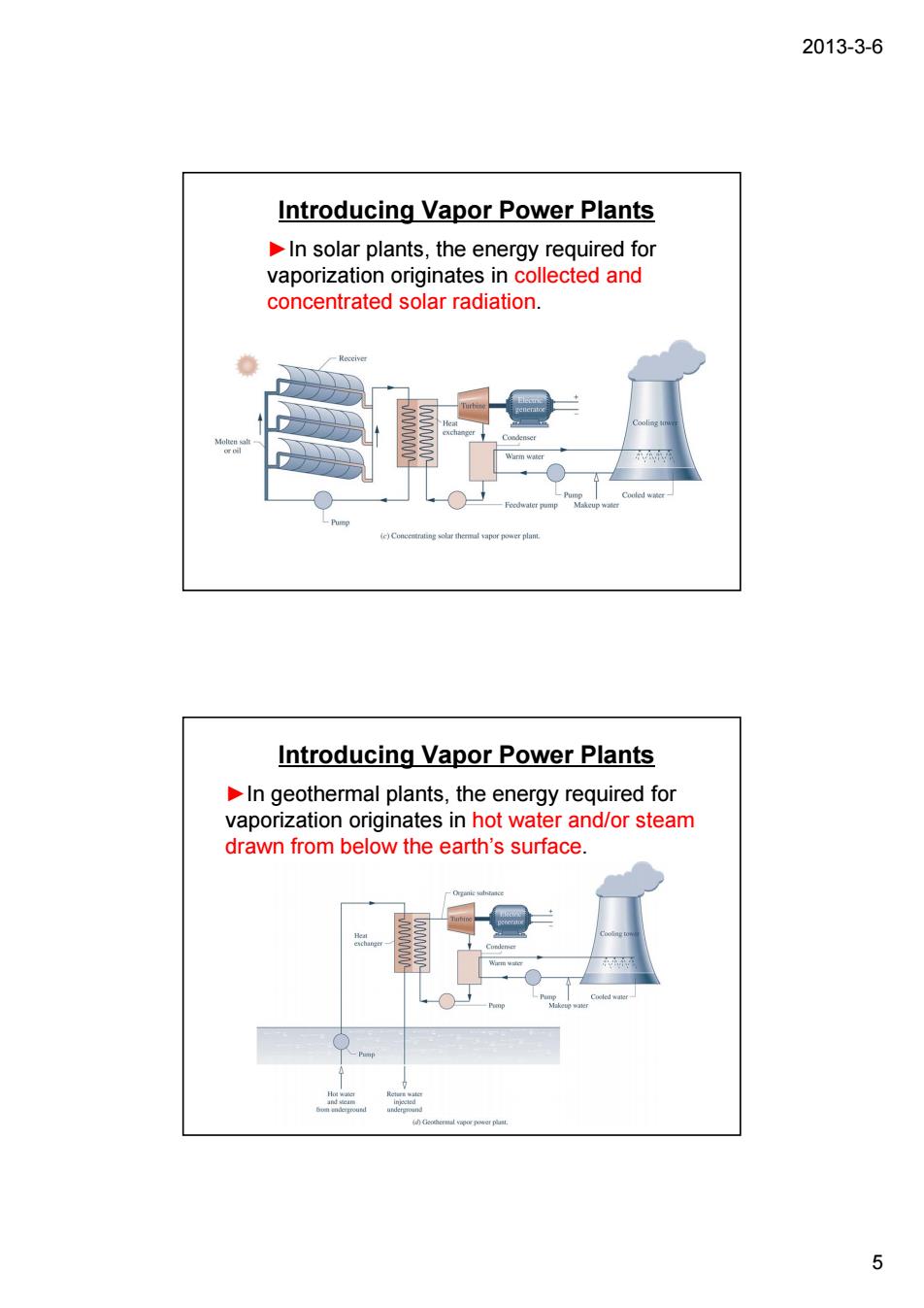
2013-3-6 Introducing Vapor Power Plants In solar plants,the energy required for vaporization originates in collected and concentrated solar radiation. Introducing Vapor Power Plants In geothermal plants,the energy required for vaporization originates in hot water and/or steam drawn from below the earth's surface. 5
2013-3-6 5 Introducing Vapor Power Plants ►In solar plants, the energy required for vaporization originates in collected and concentrated solar radiation. Introducing Vapor Power Plants ►In geothermal plants, the energy required for vaporization originates in hot water and/or steam drawn from below the earth’s surface
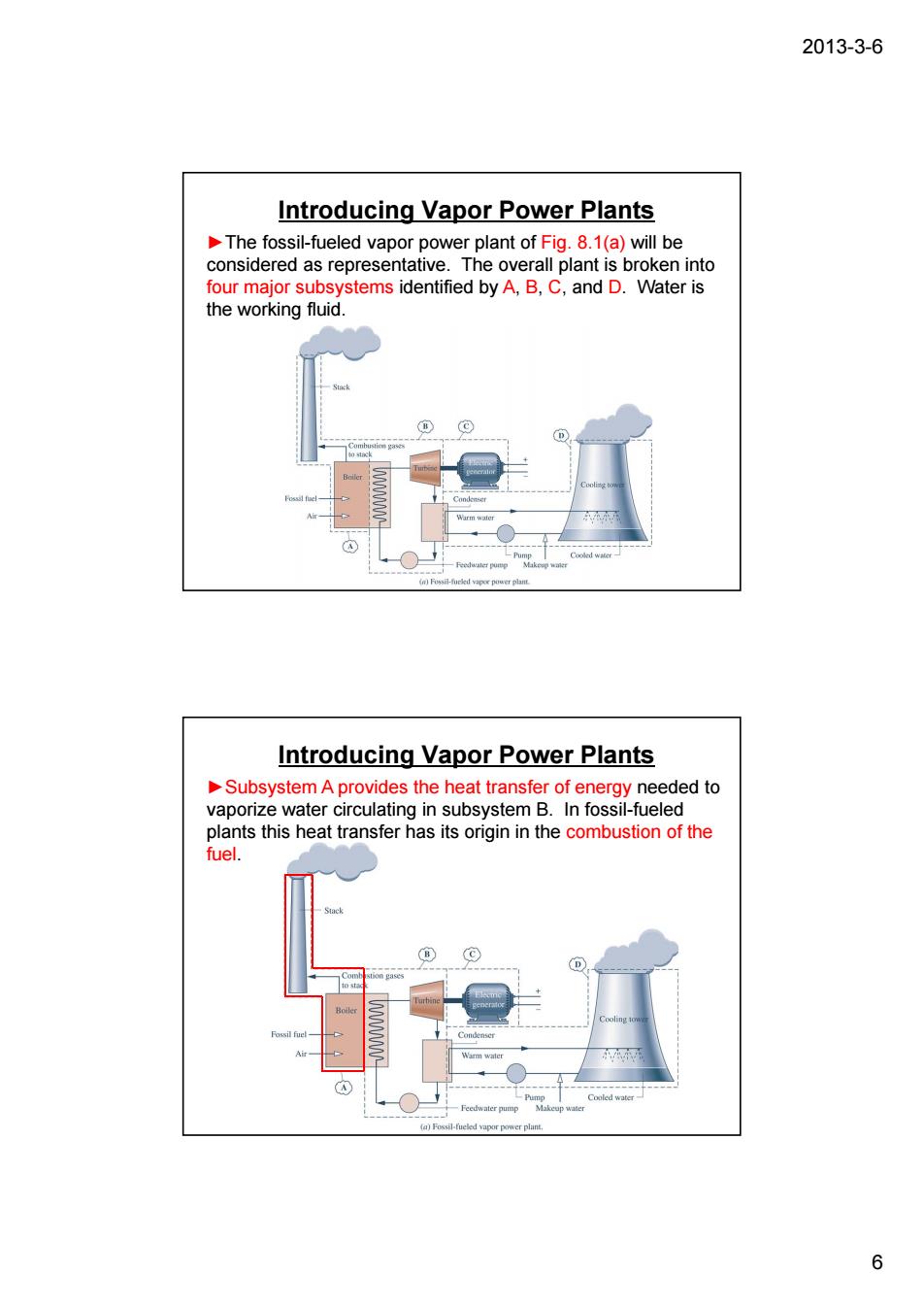
2013-3-6 Introducing Vapor Power Plants The fossil-fueled vapor power plant of Fig.8.1(a)will be considered as representative.The overall plant is broken into four major subsystems identified by A,B,C,and D.Water is the working fluid. Introducing Vapor Power Plants Subsystem A provides the heat transfer of energy needed to vaporize water circulating in subsystem B.In fossil-fueled plants this heat transfer has its origin in the combustion of the fuel. 6
2013-3-6 6 Introducing Vapor Power Plants ►The fossil-fueled vapor power plant of Fig. 8.1(a) will be considered as representative. The overall plant is broken into four major subsystems identified by A, B, C, and D. Water is the working fluid. Introducing Vapor Power Plants ►Subsystem A provides the heat transfer of energy needed to vaporize water circulating in subsystem B. In fossil-fueled plants this heat transfer has its origin in the combustion of the fuel
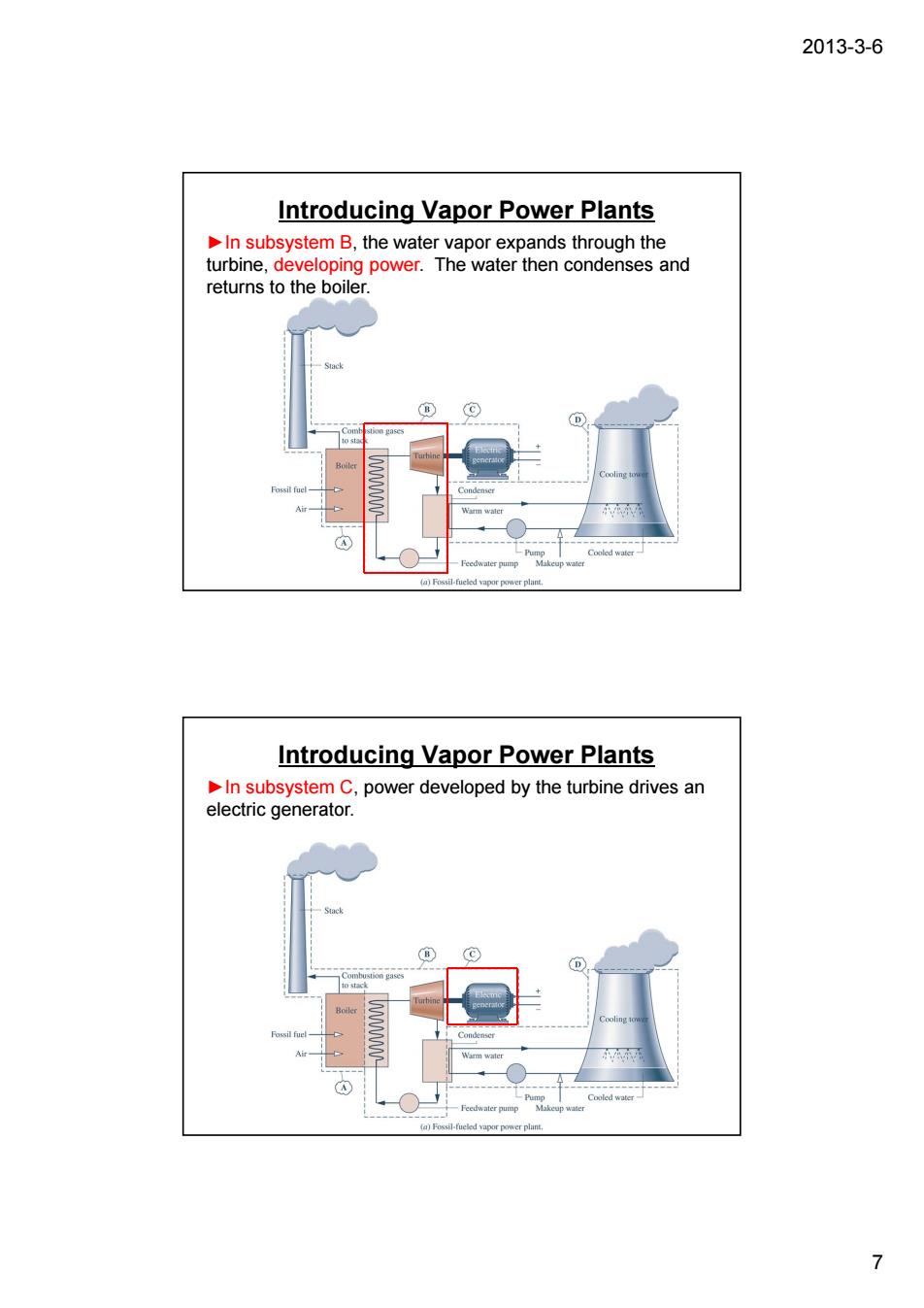
2013-3-6 Introducing Vapor Power Plants In subsystem B,the water vapor expands through the turbine,developing power.The water then condenses and returns to the boiler. Introducing Vapor Power Plants In subsystem C,power developed by the turbine drives an electric generator. 7
2013-3-6 7 Introducing Vapor Power Plants ►In subsystem B, the water vapor expands through the turbine, developing power. The water then condenses and returns to the boiler. Introducing Vapor Power Plants ►In subsystem C, power developed by the turbine drives an electric generator
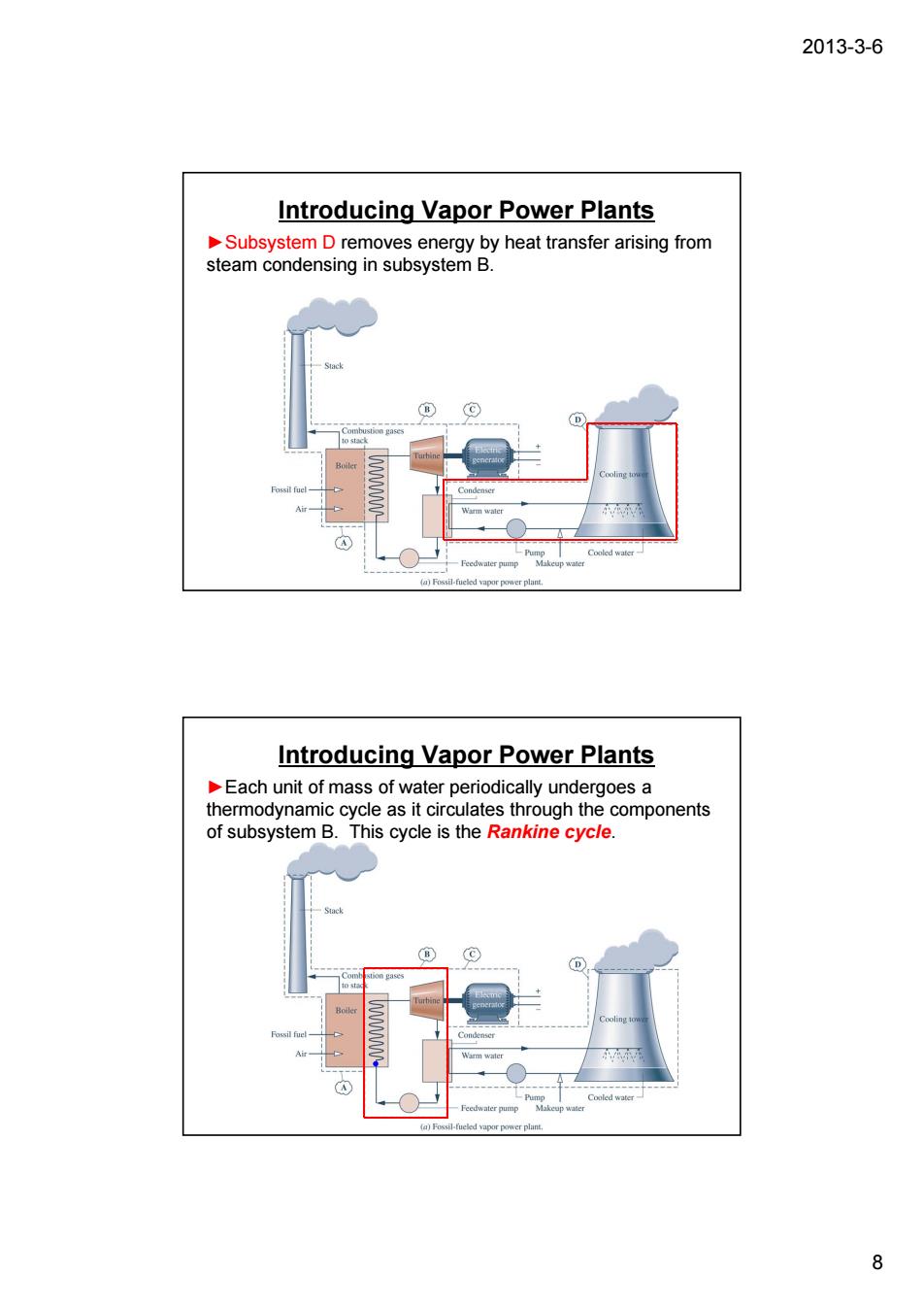
2013-3-6 Introducing Vapor Power Plants Subsystem D removes energy by heat transfer arising from steam condensing in subsystem B. Introducing Vapor Power Plants Each unit of mass of water periodically undergoes a thermodynamic cycle as it circulates through the components of subsystem B.This cycle is the Rankine cycle. 8
2013-3-6 8 Introducing Vapor Power Plants ►Subsystem D removes energy by heat transfer arising from steam condensing in subsystem B. Introducing Vapor Power Plants ►Each unit of mass of water periodically undergoes a thermodynamic cycle as it circulates through the components of subsystem B. This cycle is the Rankine cycle
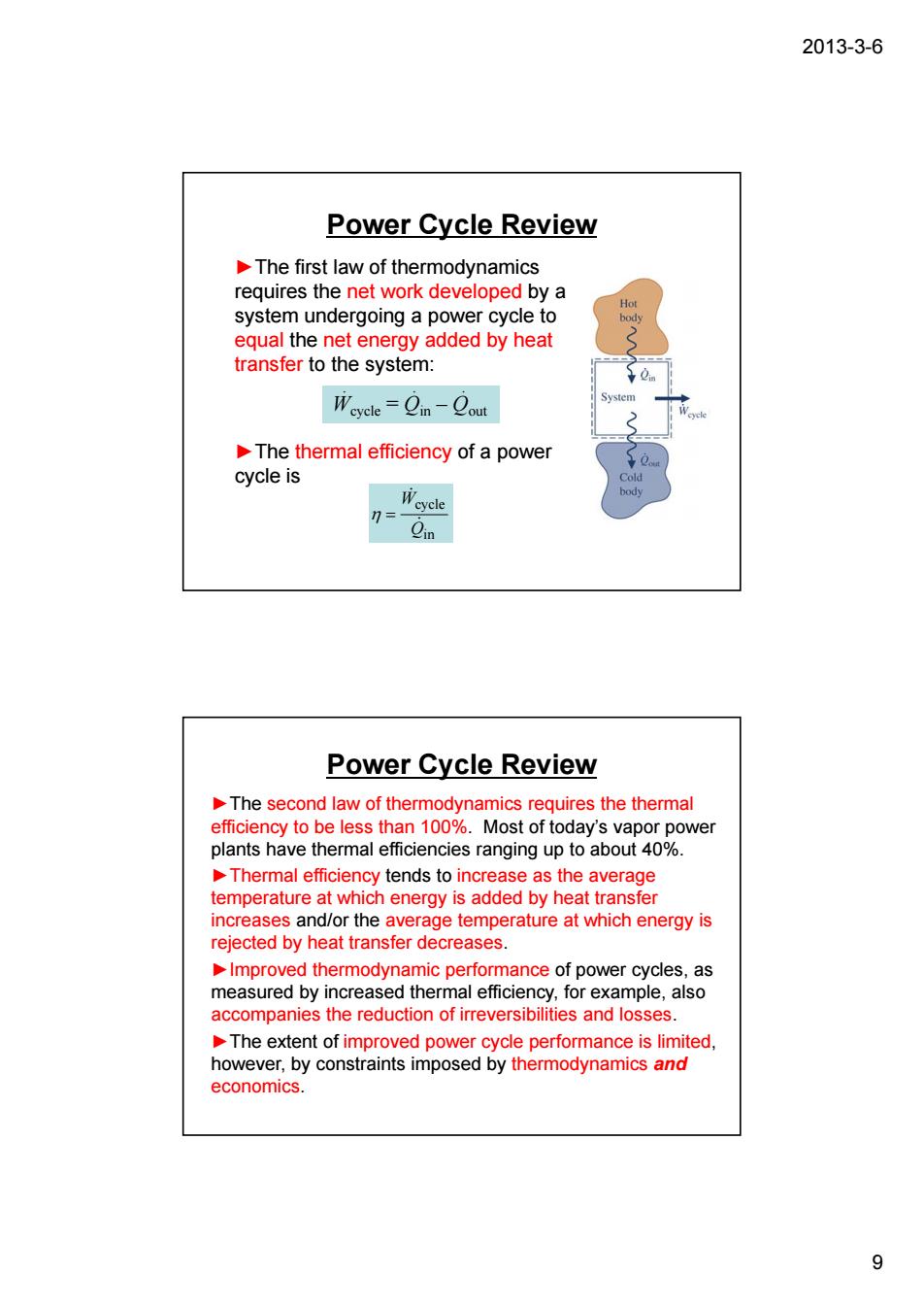
2013-3-6 Power Cycle Review The first law of thermodynamics requires the net work developed by a system undergoing a power cycle to equal the net energy added by heat transfer to the system: Weycle=Om-Cout The thermal efficiency of a power cycle is - Power Cycle Review effic 0 Thermal efficiency tends to increase as the average temperature at which energy is added by heat transfer increases and/or the average temperature at which energy is rejected by heat transfer decreases. The extent of improved power cycle performance is limited, however,by constraints imposed by thermodynamics and economics. 9
2013-3-6 9 Power Cycle Review in cycle Q W & & η = ►The first law of thermodynamics requires the net work developed by a system undergoing a power cycle to equal the net energy added by heat transfer to the system: ►The thermal efficiency of a power cycle is Wcycle = Qin – Qout · · · · · · Power Cycle Review ►The second law of thermodynamics requires the thermal efficiency to be less than 100%. Most of today’s vapor power plants have thermal efficiencies ranging up to about 40%. ►Thermal efficiency tends to increase as the average temperature at which energy is added by heat transfer increases and/or the average temperature at which energy is rejected by heat transfer decreases. ►Improved thermodynamic performance of power cycles, as measured by increased thermal efficiency, for example, also accompanies the reduction of irreversibilities and losses. ►The extent of improved power cycle performance is limited, however, by constraints imposed by thermodynamics and economics
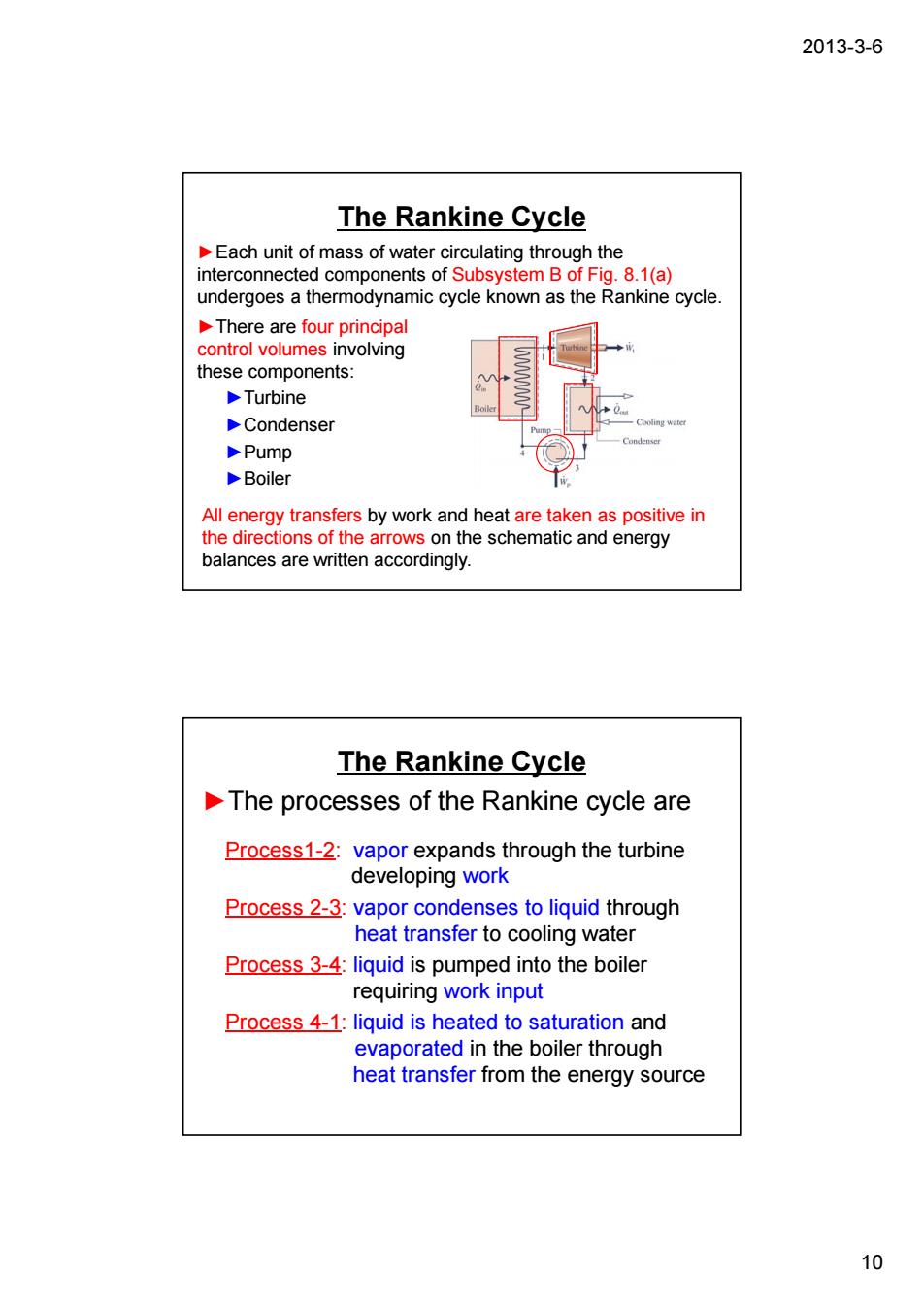
2013-3-6 The Rankine Cycle interconnect comp onents of s Fig.8.1(a) undergoes a thermodynamic cycle known as the Rankine cycle There are four principal control volumes involving these components: Turbine Condenser >Pump Boiler All energy transfers by work and heat are taken as positive in ns of the a s on the schematic and energy written accordingly. The Rankine Cycle The processes of the Rankine cycle are Process1-2:vapor expands through the turbine developing work Process 2-3:vapor condenses to liquid through heat transfer to cooling water Process 3-4:liquid is pumped into the boiler requiring work input Process 4-1:liquid is heated to saturation and evaporated in the boiler through heat transfer from the energy source 10
2013-3-6 10 The Rankine Cycle ►Each unit of mass of water circulating through the interconnected components of Subsystem B of Fig. 8.1(a) undergoes a thermodynamic cycle known as the Rankine cycle. All energy transfers by work and heat are taken as positive in the directions of the arrows on the schematic and energy balances are written accordingly. ►There are four principal control volumes involving these components: ►Turbine ►Condenser ►Pump ►Boiler The Rankine Cycle Process1-2: vapor expands through the turbine developing work Process 2-3: vapor condenses to liquid through heat transfer to cooling water Process 3-4: liquid is pumped into the boiler requiring work input Process 4-1: liquid is heated to saturation and evaporated in the boiler through heat transfer from the energy source ►The processes of the Rankine cycle are